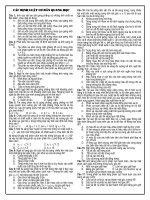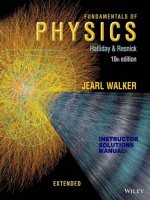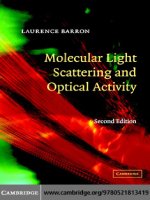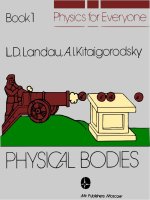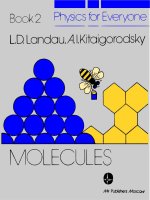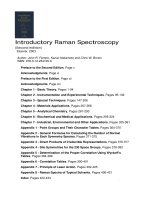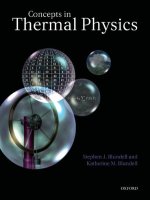- Trang chủ >>
- Khoa Học Tự Nhiên >>
- Vật lý
tài liệu vật lý molecular light scattering and optical activity
Bạn đang xem bản rút gọn của tài liệu. Xem và tải ngay bản đầy đủ của tài liệu tại đây (2.91 MB, 467 trang )
This page intentionally left blank
MOLECULAR LIGHT SCATTERING
AND OPTICAL ACTIVITY
Using classical and quantum methods with a strong emphasis on symmetry principles, this book develops the theory of a variety of optical activity and related
phenomena from the perspective of molecular scattering of polarized light. In addition to the traditional topic of optical rotation and circular dichroism in the visible
and ultraviolet region associated with electronic transitions, the newer topic of optical activity associated with vibrational transitions, which may be studied using
both infrared and Raman techniques, is also treated. Ranging from the physics of
elementary particles to the structure of viruses, the subject matter of the book reflects the importance of optical activity and chirality in much of modern science
and will be of interest to a wide range of physical and life scientists.
Laurence Barron worked with Professor Peter Atkins for his doctorate in
theoretical chemistry from Oxford University, followed by postdoctoral work with
Professor David Buckingham at Cambridge University. He was appointed to a faculty position at Glasgow University in 1975, where he is currently the Gardiner
Professor of Chemistry. His research interests are in the electric, magnetic and optical properties of molecules, especially chiral phenomena including Raman optical
activity which he pioneered and is developing as a novel probe of the structure and
behaviour of proteins, nucleic acids and viruses.
MOLECULAR LIGHT SCATTERING
AND OPTICAL ACTIVITY
Second edition, revised and enlarged
L A U R E N C E D . B A R R O N , f.r.s.e.
Gardiner Professor of Chemistry, University of Glasgow
Cambridge, New York, Melbourne, Madrid, Cape Town, Singapore, São Paulo
Cambridge University Press
The Edinburgh Building, Cambridge , UK
Published in the United States of America by Cambridge University Press, New York
www.cambridge.org
Information on this title: www.cambridge.org/9780521813419
© L. D. Barron 2004
This publication is in copyright. Subject to statutory exception and to the provision of
relevant collective licensing agreements, no reproduction of any part may take place
without the written permission of Cambridge University Press.
First published in print format 2004
-
-
---- eBook (NetLibrary)
--- eBook (NetLibrary)
-
-
---- hardback
--- hardback
Cambridge University Press has no responsibility for the persistence or accuracy of s
for external or third-party internet websites referred to in this publication, and does not
guarantee that any content on such websites is, or will remain, accurate or appropriate.
For Sharon
There are some enterprises in which a careful disorderliness is the true method.
Herman Melville, Moby Dick
Contents
Preface to the first edition
Preface to the second edition
List of symbols
1 A historical review of optical activity phenomena
1.1 Introduction
1.2 Natural optical rotation and circular dichroism
1.3 Magnetic optical rotation and circular dichroism
1.4 Light scattering from optically active molecules
1.5 Vibrational optical activity
1.6 X-ray optical activity
1.7 Magnetochiral phenomena
1.8 The Kerr and Cotton–Mouton effects
1.9 Symmetry and optical activity
page xi
xv
xviii
1
1
2
10
14
17
21
22
23
24
Spatial symmetry and optical activity • Inversion symmetry and
physical laws • Inversion symmetry and optical rotation • Inversion
symmetry and optical activity in light scattering • Motion-dependent
enantiomorphism: true and false chirality • Symmetry violation: the
fall of parity and time reversal invariance • Chirality and relativity •
Chirality in two dimensions
2 Molecules in electric and magnetic fields
2.1 Introduction
2.2 Electromagnetic waves
Maxwell’s equations • Plane monochromatic waves
energy • The scalar and vector potentials
2.3 Polarized light
Pure polarization
53
53
54
•
Force and
61
•
Partial polarization
2.4 Electric and magnetic multipole moments
vii
67
viii
Contents
Electric multipole moments • Magnetic multipole moments
electric multipole fields • Static magnetic multipole fields •
Dynamic electromagnetic multipole fields
•
Static
2.5 The energy of charges and currents in electric and
magnetic fields
Electric and magnetic multipole moments in static fields
and magnetic multipole moments in dynamic fields
78
•
Electric
2.6 Molecules in electric and magnetic fields
•
85
•
A molecule in static fields A molecule in a radiation field A
molecule in a radiation field at absorbing frequencies •
Kramers–Kronig relations • The dynamic molecular property tensors
in a static approximation
2.7 A molecule in a radiation field in the presence of
other perturbations
2.8 Molecular transition tensors
103
107
The Raman transition polarizability • The adiabatic approximation •
The vibrational Raman transition tensors in Placzek’s approximation •
Vibronic interactions: the Herzberg–Teller approximation
3 Molecular scattering of polarized light
3.1 Introduction
3.2 Molecular scattering of light
3.3 Radiation by induced oscillating molecular multipole moments
3.4 Polarization phenomena in transmitted light
123
123
124
126
127
Refraction as a consequence of light scattering • Refringent
scattering of polarized light • Simple absorption • Linear dichroism
and birefringence (the Kerr effect) • Electric field gradient-induced
birefringence: measurement of molecular electric quadrupole
moments and the problem of origin invariance • Natural optical
rotation and circular dichroism • Magnetic optical rotation and
circular dichroism • Magnetochiral birefringence and dichroism •
Nonreciprocal (gyrotropic) birefringence • The Jones birefringence •
Electric optical rotation (electrogyration) and circular dichroism
3.5 Polarization phenomena in Rayleigh and Raman
scattered light
151
Nonrefringent scattering of polarized light • Symmetric scattering •
Antisymmetric scattering • Natural Rayleigh and Raman optical
activity • Magnetic Rayleigh and Raman optical activity • Electric
Rayleigh and Raman optical activity
4 Symmetry and optical activity
4.1 Introduction
4.2 Cartesian tensors
170
170
170
ix
Contents
Scalars, vectors and tensors • Rotation of axes • Polar and axial
tensors • Some algebra of unit tensors • Isotropic averages of tensor
components • Principal axes
4.3 Inversion symmetry in quantum mechanics
187
Space inversion • Time reversal • The parity and reversality
classification of optical activity observables • Optical enantiomers,
two-state systems and parity violation • Symmetry breaking and
symmetry violation • CP violation and molecular physics
4.4 The symmetry classification of molecular
property tensors
217
Polar and axial, time-even and time-odd tensors • Neumann’s
principle • Time reversal and the permutation symmetry of molecular
property and transition tensors • The spatial symmetry of molecular
property tensors • Irreducible cartesian tensors • Matrix elements of
irreducible spherical tensor operators
4.5 Permutation symmetry and chirality
242
•
•
Chirality functions Permutations and the symmetric group
Chirality functions: qualitative completeness • Chirality functions:
explicit forms • Active and inactive ligand partitions: chirality
numbers • Homochirality • Chirality functions: concluding remarks
5 Natural electronic optical activity
5.1 Introduction
5.2 General aspects of natural optical rotation and
circular dichroism
264
264
264
•
The basic equations Optical rotation and circular dichroism through
circular differential refraction • Experimental quantities • Sum rules
5.3 The generation of natural optical activity within molecules
•
The static coupling model The dynamic coupling model
coupling (the degenerate coupled oscillator model)
•
272
Exciton
5.4 Illustrative examples
291
The carbonyl chromophore and the octant rule • The Co3+
chromophore: visible, near ultraviolet and X-ray circular dichroism
Finite helices: hexahelicene
5.5 Vibrational structure in circular dichroism spectra
•
Introduction The vibronically perturbed rotational strength
carbonyl chromophore
304
•
6 Magnetic electronic optical activity
6.1 Introduction
6.2 General aspects of magnetic optical rotation and
circular dichroism
The basic equations
C-terms
•
•
Interpretation of the Faraday A-, B- and
The
311
311
312
x
Contents
6.3 Illustrative examples
317
• The influence
Porphyrins • Charge transfer transitions in Fe(CN)3−
6
of intramolecular perturbations on magnetic optical activity: the
carbonyl chromophore
6.4 Magnetochiral birefringence and dichroism
7 Natural vibrational optical activity
7.1 Introduction
7.2 Natural vibrational optical rotation and circular dichroism
327
331
331
332
The basic equations • The fixed partial charge model • The bond
dipole model • A perturbation theory of vibrational circular dichroism
7.3 Natural vibrational Raman optical activity
•
342
•
The basic equations Experimental quantities Optical activity in
transmitted and scattered light • The two-group model of Rayleigh
optical activity • The bond polarizability model of Raman optical
activity • The bond polarizability model in forward, backward and
90◦ scattering
7.4 The bond dipole and bond polarizability models applied to
simple chiral structures
362
A simple two-group structure • Methyl torsions in a hindered
single-bladed propellor • Intrinsic group optical activity tensors
7.5 Coupling models
7.6 Raman optical activity of biomolecules
8 Antisymmetric scattering and magnetic Raman optical activity
8.1 Introduction
8.2 Symmetry considerations
8.3 A vibronic development of the vibrational Raman
transition tensors
8.4 Antisymmetric scattering
379
381
385
385
386
388
393
The antisymmetric transition tensors in the zeroth-order
Herzberg–Teller approximation • Resonance Rayleigh scattering in
atomic sodium • Resonance Raman scattering in totally symmetric
vibrations of iridium (IV) hexahalides • Antisymmetric transition
tensors generated through vibronic coupling • Resonance Raman
scattering in porphyrins
8.5 Magnetic Rayleigh and Raman optical activity
The basic equations • Resonance Rayleigh scattering in atomic
sodium • Vibrational resonance Raman scattering in IrCl2−
6 and
2−
CuBr4 : Spin-flip transitions and Raman electron paramagnetic
resonance • Electronic resonance Raman scattering in uranocene
Resonance Raman scattering in porphyrins
References
Index
407
•
423
436
Preface to the first edition
Scientists have been fascinated by optical activity ever since its discovery in the
early years of the last century, and have been led to make major discoveries in
physics, chemistry and biology while trying to grapple with its subtleties. We can
think of Fresnel’s work on classical optics, Pasteur’s discovery of enantiomeric pairs
of optically active molecules which took him into biochemistry and then medicine,
and Faraday’s conclusive demonstration of the intimate connection between electromagnetism and light through his discovery of magnetic optical activity. And of
course the whole subject of stereochemistry, or chemistry in space, has its roots
in the realization by Fresnel and Pasteur that the molecules which exhibit optical
rotation must have an essentially helical structure, so from early on molecules were
being thought about in three dimensions.
A system is called ‘optically active’ if it has the power to rotate the plane of
polarization of a linearly polarized light beam, but in fact optical rotation is just
one of a number of optical activity phenomena which can all be reduced to the
common origin of a different response to right- and left-circularly polarized light.
Substances that are optically active in the absence of external influences are said
to exhibit ‘natural’ optical activity. Otherwise, all substances in magnetic fields are
optically active, and electric fields can sometimes induce optical activity in special
situations.
It might be thought that a subject originating at the start of the nineteenth century
would be virtually exhausted by now, but nothing could be further from the truth.
The recent dramatic developments in optical and electronic technology have led
to large increase in the sensitivity of conventional optical activity measurements,
and have enabled completely new optical activity phenomena to be observed and
applied. Traditionally, optical activity has been associated almost exclusively with
electronic transitions; but one particularly significant advance over the last decade
has been the extension of natural optical activity measurements into the vibrational
spectrum using both infrared and Raman techniques. It is now becoming clear
xi
xii
Preface to first edition
that vibrational optical activity makes possible a whole new world of fundamental
studies and practical applications quite undreamt of in the realm of conventional
electronic optical activity.
Optical activity measurements are expected to become increasingly important
in chemistry and biochemistry. This is because ‘conventional’ methods have now
laid the groundwork for the determination of gross molecular structure, and emphasis is turning more and more towards the determination of the precise threedimensional structures of molecules in various environments: in biochemistry it is
of course the fine detail in three dimensions that is largely responsible for biological
function. Whereas X-ray crystallography, for example, provides such information
completely, it is restricted to studies of molecules in crystals in which the three
dimensional structures are not necessarily the same as in the environment of interest.
Natural optical activity measurements are a uniquely sensitive probe of molecular
stereochemistry, both conformation and absolute configuration, but unlike X-ray
methods can be applied to liquid and solution samples, and even to biological
molecules in vivo. The significance of magnetic optical activity measurements, on
the other hand, can probably be summarized best by saying that they inject additional structure into atomic and molecular spectra, enabling more information to
be extracted.
Following the recent triumph of theoretical physics in unifying the weak and
electromagnetic forces into a single ‘electroweak’ force, the world of physics has
also started to look at optical activity afresh. Since weak and electromagnetic forces
have turned out to be different aspects of the same, more fundamental, unified
force, the absolute parity violation associated with the weak force is now thought
to infiltrate to a tiny extent into all electromagnetic phenomena, and this can be
studied in the realm of atoms and molecules by means of delicate optical activity
experiments. So just as optical activity acted as a catalyst in the progress of science
in the last century, in our own time it appears set to contribute to further fundamental
advances. One could say that optical activity provides a peephole into the fabric of
the universe!
In order to deal with the optical properties of optically active substances in a
unified fashion, and to understand the relationship between the conventional ‘birefringence’ phenomena of optical rotation and circular dichroism and the newer
‘scattering’ phenomena of Rayleigh and Raman optical activity, the theory is developed in this book from the viewpoint of the scattering of polarized light by
molecules. In so doing, a general theory of molecular optics is obtained and is applied to the basic phenomena of refraction, birefringence and Rayleigh and Raman
scattering. Optical activity experiments are then regarded as applications of these
phenomena in ways that probe the asymmetry in the response of the optically active
system to right- and left-circularly polarized light. As well as using the results of the
Preface to first edition
xiii
general theory to obtain expressions for the observables in each particular optical
activity phenomenon, where possible the expressions are also derived separately in
as simple a fashion as possible for the benefit of the reader who is interested in one
topic in isolation.
There are several important topics within the general area of optical activity that
I have either omitted or mentioned only briefly, mainly because they are outwith
the theme of molecular scattering of polarized light, and also because of my lack
of familiarity with them. These include circular polarization of luminescence, and
chiral discrimination. I have also not treated helical polymers: to do justice to this
very important topic would divert us too far from the fundamental theory. Where I
have discussed specific atomic or molecular systems, this has been to illuminate the
theory rather than to give an exhaustive explanation of the optical activity of any
particular system. For a much broader view of natural optical activity, including
experimental aspects and a detailed account of a number of specific systems, the
reader is referred to S. F. Mason’s new book ‘Molecular Optical Activity and the
Chiral Discriminations’ (Mason, 1982).
So this is not a comprehensive treatise on optical activity. Rather, it is a personal
view of the theory of optical activity and related polarized light scattering effects
that reflects my own research interests over the last 14 years or so. During the earlier
part of this period I was fortunate to work with, and learn from, two outstanding
physical chemists: Dr P. W. Atkins in Oxford and Professor A. D. Buckingham in
Cambridge; and their influence extends throughout the book.
I wish to thank the many colleagues who have helped to clarify much of the
material in this book through discussion and correspondence over the years. I am
particularly grateful to Dr J. Vrbancich for working through the entire manuscript
and pointing out many errors and obscure passages.
Glasgow
May 1982
Preface to the second edition
Interest in optical activity has burgeoned since the first edition of this book was
published in 1982. The book anticipated a number of new developments and helped
to fuel this interest, but has become increasingly hard to find since going out of print
in 1990. Numerous requests about where a copy might be found, often accompanied by ‘our library copy has been stolen’ and the suggestion that a second edition
would be well-received, have encouraged me to prepare this new edition. The book
has been considerably revised and enlarged, but the general plan and style remain
as before.
Traditionally, the field of optical activity and chirality has been largely the preserve of synthetic and structural chemistry due to the inherent chirality of many
molecules, especially natural products. It has also been important in biomolecular science since proteins, nucleic acids and oligosaccharides are constructed from
chiral molecular building blocks, namely the L-amino acids and the D-sugars,
and the chemistry of life is exquisitely stereospecific. The field is becoming increasingly important in these traditional areas. For example, chirality and enantioselective chemistry are now central to the pharmaceutical industry since many
drugs are chiral and it has been recognized that they should be manufactured as
single enantiomers; and chiroptical spectroscopies are used ever more widely for
studying the solution structure and behaviour of biomolecules, a subject at the
forefront of biomedical science. But in recent years optical activity and chirality have also been embraced enthusiastically by several other disciplines. Physicists, for example, are becoming increasingly interested in the field due to the
subtle new optical phenomena, linear and nonlinear, supported by chiral fluids,
crystals and surfaces. Furthermore, since homochiral chemistry is the signature
of life, and considerable effort is being devoted to searches for evidence of life,
or at least of prebiotic chemistry, elsewhere in the cosmos including interstellar
xv
xvi
Preface to second edition
dust clouds, cometary material and the surfaces of extrasolar planets, chirality
has captured the interest of some astrophysicists and space scientists. It has even
caught the attention of applied mathematicians and electrical engineers on account of the novel and potentially useful electromagnetic properties of chiral
media.
Although containing a significant amount of new material the second edition, like
the first, is not a comprehensive treatise on optical activity and remains a personal
view of the theory of optical activity and related polarized light scattering effects
that reflects my own research interests. The material on symmetry and chirality has
been expanded to include motion-dependent enantiomorphism and the associated
concepts of ‘true’ and ‘false’ chirality, and to expose productive analogies between
the physics of chiral molecules and that of elementary particles which are further
emphasized by considering the violation of parity and time reversal invariance.
Another significant addition is a detailed treatment of magnetochiral phenomena,
which are generated by a subtle interplay of chirality and magnetism and which
were unknown at the time of writing the first edition. Since vibrational optical
activity has now ‘come of age’ thanks to new developments in instrumentation and
theory in the 1980s and 1990s, the treatment of this topic has been considerably
revised and expanded. Of particular importance is a new treatment of vibrational
circular dichroism in Chapter 7; serious problems in the quantum chemical theory,
now resolved, were unsolved at the time of writing the first edition, which contains
an error in the way in which the Born–Oppenheimer approximation was applied.
The revised material on natural Raman optical activity now reflects the fact that it
has become an incisive chiroptical technique giving information on a vast range
of chiral molecular structures, from the smallest such as CHFClBr to the largest
such as intact viruses. New developments in magnetic Raman optical activity are
also described which illustrate how it may be used as a novel probe of magnetic
structure.
Another subject to come of age in recent years is nonlinear optical activity, manifest as a host of different optical phenomena generated by intense laser beams
incident on both bulk and surface chiral samples. However the subject has become
too large and important, and too specialized with respect to its theoretical development, to do it justice within this volume which is therefore confined to linear
optical activity phenomena.
I have benefited greatly from interactions with many colleagues who have helped
directly and indirectly with the identification and correction of errors in the first edition, and with the preparation of new material. I am especially grateful in this respect
to E. W. Blanch, I. H. McColl, A. D. Buckingham, J. H. Cloete, R. N. Compton,
J. D. Dunitz, K.-H. Ernst, R. A. Harris, L. Hecht, W. Hug, T. A. Keiderling, L. A.
Preface to second edition
xvii
Nafie, R. D. Peacock, P. L. Polavarapu, M. Quack, R. E. Raab, G. L. J. A. Rikken,
A. Rizzo, P. J. Stephens, G. Wagni`ere and N. I. Zheludev.
I hope that workers in many different areas of pure and applied science will find
something of value in this second edition.
Glasgow
2004
Symbols
The symbols below are grouped according to context. In some cases the same
symbol has more than one meaning, but it is usually clear from the context which
˜ denotes a complex
meaning is to be taken. A tilde above a symbol, for example A,
quantity, the complex conjugate being denoted by an asterisk, for example A˜ ∗ . A
˙ denotes the time derivative of the corresponding
dot over a symbol, for example A,
quantity. An asterisk is also used to denote an antiparticle or an antiatom, for
example ν ∗ and Co∗ .
Historical review
α
optical rotation angle
[α]
specific rotation
ψ
ellipticity
[ψ]
specific ellipticity
decadic molar extinction coefficient
g
dissymmetry factor
V
Verdet constant
dimensionless Rayleigh or Raman circular intensity difference
R,S
absolute configuration in the Cahn–Ingold–Prelog notation. (R)-(+) etc.
specifies the sense of optical rotation associated with a particular
absolute configuration
P,M
helicity designation of the absolute configuration of helical molecules
Electric and magnetic fields and electromagnetic waves
λ
wavelength
c
velocity of light
v
wave velocity
ω
angular frequency, magnitude 2πv/ λ (2π c/ λ in free space)
n
refractive index, magnitude c/v
absorption index
n
xviii
List of symbols
n˜
n
κ
E
B
D
H
ρ
J
N
I
φ
A
P
M
Q
µ
0
µ0
complex refractive index n + in
propagation vector, magnitude n
wavevector, magnitude ω/v (may be written ωn/c)
electric field vector in free space
magnetic field vector in free space
electric field vector within a medium
magnetic field vector within a medium
electric charge density
electric current density
Poynting vector
intensity (time average of |N|)
scalar potential
vector potential
bulk polarization
bulk magnetization
bulk quadrupole polarization
dielectric constant
magnetic permeability
permittivity of free space
permeability of free space
Polarized light
η
θ
S0 , S1 , S2 , S3
P
˜
Π
ρ˜ αβ
ellipticity of the polarization ellipse
azimuth of the polarization ellipse
Stokes parameters
degree of polarization
complex polarization vector
complex polarization tensor
Geometry and symmetry
i,j,k
unit vectors along space-fixed axes x,y,z.
I,J,K
unit vectors along molecule-fixed axes X ,Y ,Z .
r
position vector
direction cosine between the λ and α axes (cos−1l λ α is the angle
lλ α
between the λ and α axes)
Kronecker delta
δαβ
alternating tensor
εαβγ
∇α ∇β . . . R −1
Tαβ...
P
parity operation
T
classical time reversal operation
xix
xx
C
p
2πb
a
[ 2]
{ 2}
D ( j)
Tqk
List of symbols
charge conjugation operation
eigenvalue of P
helix pitch
helix radius
symmetric part of the direct product of the representation with itself
antisymmetric part of the direct product of the representation with
itself
irreducible representation of the proper rotation group R3+
irreducible spherical tensor operator
Classical mechanics
v
velocity vector
p
linear momentum vector
L
angular momentum vector
F
Lorentz force vector
W
total energy
T
kinetic energy
V
potential energy
L
Lagrangian function
H
Hamiltonian function
generalized momentum vector
p
normal coordinate for the pth normal mode of vibration
Qp
P
momentum conjugate to Q p , namely Q˙ p
sq
qth internal vibrational coordinate
L
vibrational L-matrix
Quantum mechanics
h
Planck constant
h¯
h/2π
ψ
wavefunction
H
Hamiltonian operator
electronic, vibrational, rotational parts of the jth quantum state
ej, vj,rj
j, m
general angular momentum quantum number, associated magnetic
quantum number, of a particle
orbital angular momentum quantum number, associated magnetic
l, m l
quantum number, of a particle
spin angular momentum quantum number, associated magnetic
s, m s
quantum number, of a particle
J, M
total angular momentum quantum number, associated magnetic
quantum number, of an atom or molecule
List of symbols
K
gi
Θ
AT
A† = A T ∗
Ylm
2δ
2
G
α
g
QW
θW
σ
Z
[a, b]
{a, b}
xxi
quantum number specifying the projection of the total angular
momentum onto the principal axis of a symmetric top
g-value of the ith particle spin
quantum mechanical time reversal operator
eigenvalue of Θ2
transpose of operator A
Hermitian conjugate of operator A
spherical harmonic function
tunnelling splitting
parity-violating energy difference between chiral enantiomers
Fermi weak coupling constant
fine structure constant
weak charge
effective weak charge
Weinberg electroweak mixing angle
Pauli spin operator
proton number
commutator ab − ba
anticommutator ab + ba
Molecular properties
electric charge of the ith particle (+e for the proton, −e for the
ei
electron)
q
net charge or electric monopole moment
µ
electric dipole moment vector
m
magnetic dipole moment vector
Θαβ
traceless electric quadrupole moment tensor
real part of the electric dipole–electric dipole polarizability tensor
ααβ
imaginary part of the electric dipole–electric dipole polarizability
ααβ
tensor
real part of the electric dipole–magnetic dipole optical activity tensor
G αβ
imaginary part of the electric dipole–magnetic dipole optical
G αβ
activity tensor
real part of the electric dipole–electric quadrupole optical activity
Aα,βγ
tensor
imaginary part of the electric dipole–electric quadrupole optical
Aα,βγ
activity tensor
real part of the magnetic dipole–electric dipole optical activity tensor
Gαβ
imaginary part of the magnetic dipole–electric dipole optical
G αβ
activity tensor
xxii
Aα,βγ
A α,βγ
α˜ αβ , etc.
α
G
β(α)2
β(G )2
β(A)2
κ
List of symbols
real part of the electric quadrupole–electric dipole optical activity
tensor
imaginary part of the electric quadrupole–electric dipole optical
activity tensor
complex polarizability ααβ −iα αβ , etc. (the minus sign arises from
the choice of sign in the exponents of the complex dynamic electric
and magnetic fields)
isotropic invariant of ααβ
isotropic invariant of G αβ
anisotropic invariant of ααβ
anisotropic invariant of G αβ
anisotropic invariant of Aα,βγ
dimensionless polarizability anisotropy
Spectroscopy
[ θ]
specific rotation
η
ellipticity
Rayleigh or Raman scattered intensity in right (R)- or left
I R, I L
(L)-circularly polarized incident light
D( j ← n)
dipole strength for the j ← n transition
R( j ← n)
rotational strength for the j ← n transition
h¯ δ
Zeeman splitting
A, B, C
Faraday A-, B- and C-terms
1
A historical review of optical activity phenomena
Yet each in itself – this was the uncanny, the antiorganic, the life-denying
character of them all – each of them was absolutely symmetrical, icily
regular in form. They were too regular, as substance adapted to life never
was to this degree – the living principle shuddered at this perfect precision, found it deathly, the very marrow of death – Hans Castorp felt he
understood now the reason why the builders of antiquity purposely and
secretly introduced minute variations from absolute symmetry in their
columnar structures.
Thomas Mann (The Magic Mountain)
1.1 Introduction
In the Preface, an optical activity phenomenon was defined as one whose origin may
be reduced to a different response of a system to right- and left-circularly polarized
light. This first chapter provides a review, from a historical perspective, of the main
features of a range of phenomena that can be classified as manifestations of optical
activity, together with a few effects that are related but are not strictly examples
of optical activity. The reader is referred to the splendid books by Lowry (1935),
Partington (1953) and Mason (1982) for further historical details.
The symbols and units employed in this review are those encountered in the
earlier literature, which uses CGS units almost exclusively; but these are not necessarily the same as those used in the rest of the book in which the theory of many
of the phenomena included in the review are developed in detail from the unified
viewpoint of the molecular scattering of polarized light. In particular, the theoretical
development in subsequent chapters employs SI units since these are currently in
favour internationally.
1


